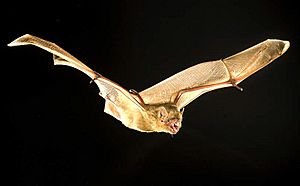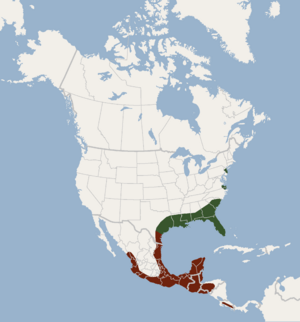Northern yellow bat facts for kids
Quick facts for kids Northern yellow bat |
|
|---|---|
 |
|
| Conservation status | |
| Scientific classification | |
| Genus: |
Dasypterus
|
| Species: |
intermedius
|
 |
|
| Distribution of the Northern Yellow bat (2009) | |
The northern yellow bat (Dasypterus intermedius) is a fascinating type of bat. It belongs to a group of bats called Vespertilionidae. These bats are usually active all year long. However, if the winter weather gets super cold, they can go into a deep sleep called torpor. This helps them save energy when food is scarce.
What They Look Like
The northern yellow bat is about 14 centimeters long. That's roughly the length of a regular pencil! It weighs between 14 and 31 grams, which is about as much as a few coins. Its wingspan can be quite wide, from 35 to 41 centimeters. Imagine a ruler and a half!
Their fur can be different colors. It might be a bright yellow-orange or a soft gray-brown. The tips of their fur are often darker.
Where They Live
You can mostly find the northern yellow bat along the coastal areas of the southeastern United States. They are also common in eastern Texas. Beyond the U.S., they live in Cuba, Mexico, Belize, Costa Rica, El Salvador, Guatemala, and Honduras. Sometimes, they have even been spotted further north in Virginia, North Carolina, and Pennsylvania.
These bats prefer to live in wooded areas. They like places near permanent bodies of water, like rivers or lakes. Coastal habitats are also favorites, especially if there is Spanish moss or palm trees. They often make their homes right inside the Spanish moss. They also like to roost under the dead, hanging fronds of palm trees.
What They Eat
Northern yellow bats are insect eaters. They love to munch on many different kinds of bugs. Their diet includes true bugs, flies, and mosquitoes. They also enjoy beetles, leafhoppers, and flying ants. Sometimes, if they are lucky, they might even catch damselflies and dragonflies.
Reproduction
Northern yellow bats usually mate in the autumn. Sometimes, they might even mate during the winter months. The baby bats, called pups, are born in late May or early June. A mother bat typically gives birth to two pups at a time. These young bats learn to fly between June and August.
See also
 In Spanish: Dasypterus intermedius para niños
In Spanish: Dasypterus intermedius para niños


